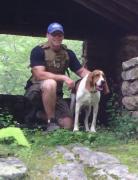I feel your pain. After using Malkoff's high-low bezel switch for a while, I've become a huge fan of this simple mechanical UI: tighten the bezel for high, loosen it for low - zero surprises when the light is activated. My "programmable" lights are now left for casual utilitarian tasks, as are those lights that change mode by multiple pokes of the tail cap switch.
The "back splatter" of reflected light can be somewhat mitigated with a narrow beam, but for indoor search I truly prefer a wide, even flood beam with a soft edge (like the Malkoff Wildcat v.6). Outdoors I find the hard edge of a reflector design is not a distraction and a powerful hot spot is very useful. For outdoor work I have yet to find anything I like better than the Malkoff Hound Dog 18650.
Not trying to turn this excellent thread on technique into a gear discussion (or a Malkoff advertisement), but one should be aware of beam and UI choices, and the strengths/limitations of any light they chose to work their technique with.





 Reply With Quote
Reply With Quote






